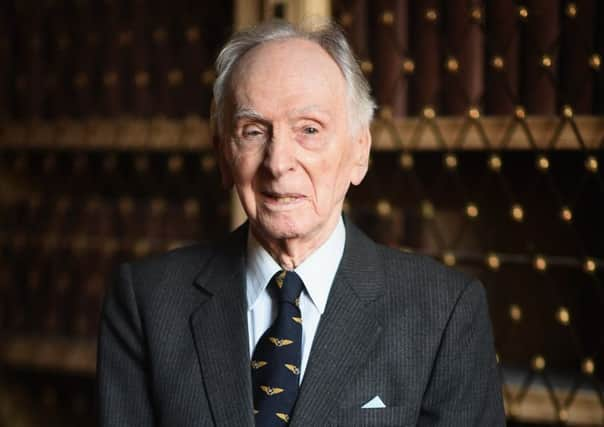Obituary: Captain Eric '˜Winkle' Brown, CBE, DSC and AFC


During his hectic years with the Fleet Air Arm it is thought Captain Eric Brown flew around 487 different types of aircraft and made 2,407 deck landings at sea and 2,721 catapult launches: records unlikely ever to be matched. This modest and genial man was a much respected aviator and a renowned test pilot.
He was admired by his colleagues for his command of machines and ability to adapt and master so many different aircrafts. Brown flew gliders, fighters, bombers, airliners, amphibians, flying boats and helicopters. His contribution to aviation research and development was immense and he was even involved in an advisory capacity in assessing the German rockets being built at Peenemunde.
Advertisement
Hide AdAdvertisement
Hide AdBrown was the first man to land a jet plane on an aircraft carrier at sea and last year was honoured at No 10 Downing Street as a Great Scot.
But his career as an aviator might never have begun - he could easily have languished in a prisoner of war camp throughout the war.
Eric Melrose Brown was known as “Winkle” as he only stood 5ft 7in tall. His father had been in the Royal Scots but transferred to the Royal Flying Corps during the First World War. His mother died when he was in his teens. He won a scholarship to the Royal High School and was runner-up to Dux of the school and in the 1st XV. He is fondly remembered at the RHS, the Rector, Pauline Walker told The Scotsman yesterday. “Winkle was an inspirational figure at the school. He was a formidable linguist and at the Mountbatten Lectures recently he spoke to some of the pupils and regaled them with stories of his time in the former buildings by the Calton Hill. He also gave an address to the school in 2010. He was a marvellous man and a real character.”
Brown then read Modern Languages at Edinburgh University concentrating on German. Significantly, he joined the University Air Unit, flying from Turnhouse.
In 1936 his father took Brown to watch the Olympics in Berlin where they met Herman Göring and Ernst Udet, both First World War fighter aces. Udet took young Brown up for a spin and declared Brown a natural pilot.
As part of his training to be a teacher Brown spent a year as an exchange teacher in Nazi Germany in 1939. One morning in September there was consternation in the hotel. Two burly SS bashed open the door and shouted, “Our countries are at war. You will come with us.”
For three days Brown was interrogated and he presumed he would be considered an alien and imprisoned. But the officers told him he was free. He was taken to his much loved MG Magnette sports car and the Swiss Border.
Brown immediately volunteered for the Fleet Air Arm and his first sorties were to escort the Atlantic convoys getting involved in dog-fights and shooting down several German bombers for which he was awarded the DSC.
Advertisement
Hide AdAdvertisement
Hide AdHis proficiency as a pilot was recognised when he was posted to test the newly navalised versions of the Hurricane and Spitfire. Once when testing a Spitfire over the Firth of Forth Brown was so thrilled with the plane that he decided to celebrate by flying circles round each strand of the famous rail bridge. His action was reported to the police at Dalmeny but the number of the plane was never recorded.
From 1943 he carried out extensive research on deck landings at sea before becoming the chief naval test pilot at the Royal Aircraft Establishment (1944 – 1950).
At the end of the war, because of his fluency in German, Brown was transferred to act as an interviewer/interpreter of many Nazis. Perhaps the most notorious was the “Beast of Belsen” — Josef Kramer the camp’s commandant and then Heinrich Himmler who Brown considered a “snivelling coward”. He interviewed Göring of whom Brown asked his opinion of the Battle of Britain: Göring said, “a draw”.
After three years in the 1950s Brown was transferred to the US Navy during the Korean War to carry out further research, then commanded 804 Naval Air Squadron, flying the Sea Hawk fighter-bomber, and in 1957 he returned to Germany to train the new German naval air force.
In 1957 he served at the Admiralty and in typically robust style asked the then defence secretary Denis Healey, “Are you still a communist?” when Brown suspected he was about to cut the Fleet Air Arm. Brown served with distinction as commander of HMS Fulmar, then the Royal Naval Air Station at Lossiemouth (1967 – 70) and retired in 1970. He was appointed a naval aide de camp to the Queen and appointed a CBE.
Brown remained an ardent Scot all his life – he retained a strong Scottish burr when speaking as was heard when he was the special guest on the 3000th edition of Desert Island Discs in 2014. Proud of his early years in Edinburgh he chose the band of the Royal Scots Dragoon Guards playing Amazing Grace.
In 2008 he was awarded an honorary degree from Edinburgh University. In a recent interview Brown said, “I’ll relive my life as it was… all the way through.” Brown married Evelyn (Lynn) Macrory in 1942; she predeceased him. He is survived by their son and Jean his partner of recent years.